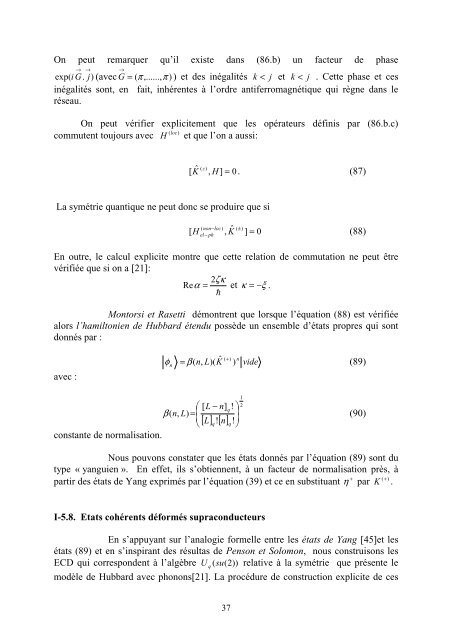Annexe IV Modèle de Hubbard standard et états cohérents - Toubkal
Annexe IV Modèle de Hubbard standard et états cohérents - Toubkal
Annexe IV Modèle de Hubbard standard et états cohérents - Toubkal
Create successful ePaper yourself
Turn your PDF publications into a flip-book with our unique Google optimized e-Paper software.
On peut remarquer qu’il existe dans (86.b) un facteur <strong>de</strong> phase→→→exp( i G . j ) (avec G = ( π ,......, π ) ) <strong>et</strong> <strong>de</strong>s inégalités k < j <strong>et</strong> k < j . C<strong>et</strong>te phase <strong>et</strong> cesinégalités sont, en fait, inhérentes à l’ordre antiferromagnétique qui règne dans leréseau.On peut vérifier explicitement que les opérateurs définis par (86.b.c)(loc)commutent toujours avec H <strong>et</strong> que l’on a aussi:ˆ ( )[ K z , H ] = 0. (87)La symétrie quantique ne peut donc se produire que si( non−loc)[ , ˆ ( ± )Hel phK ] = 0(88)−En outre, le calcul explicite montre que c<strong>et</strong>te relation <strong>de</strong> commutation ne peut êtrevérifiée que si on a [21]:2ζκRe α = <strong>et</strong> κ = −ξ.hMontorsi <strong>et</strong> Ras<strong>et</strong>ti démontrent que lorsque l’équation (88) est vérifiéealors l’hamiltonien <strong>de</strong> <strong>Hubbard</strong> étendu possè<strong>de</strong> un ensemble d’états propres qui sontdonnés par :avec :n L Kˆ(+) nφ = β ( , )( vi<strong>de</strong>(89)n)⎛ [ L − n]q!⎞β ( n,L)= ⎜ ⎟[ ] ![ ] !⎝ Lqnq ⎠(90)constante <strong>de</strong> normalisation.Nous pouvons constater que les états donnés par l’équation (89) sont dutype « yanguien ». En eff<strong>et</strong>, ils s’obtiennent, à un facteur <strong>de</strong> normalisation près, à+(+)partir <strong>de</strong>s états <strong>de</strong> Yang exprimés par l’équation (39) <strong>et</strong> ce en substituant η par K .12I-5.8. Etats cohérents déformés supraconducteursEn s’appuyant sur l’analogie formelle entre les états <strong>de</strong> Yang [45]<strong>et</strong> lesétats (89) <strong>et</strong> en s’inspirant <strong>de</strong>s résultas <strong>de</strong> Penson <strong>et</strong> Solomon, nous construisons lesECD qui correspon<strong>de</strong>nt à l’algèbre U q(su(2))relative à la symétrie que présente lemodèle <strong>de</strong> <strong>Hubbard</strong> avec phonons[21]. La procédure <strong>de</strong> construction explicite <strong>de</strong> ces37
















